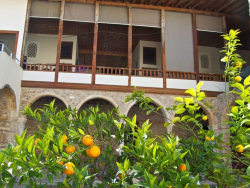Mansion of Venizelos

Mansion of Venizelos
Angelos Venizelos was born in 1490, married Syrigi Paleologina and begot a daughter, Regula Venizelos, who later became a nun by the name of Filothei. Because of her philanthropic work, Filothei angered the Turks, who arrested her during the night of October 2nd, 1588, and after she was brutally tortured, she succumbed to her injuries on February 19th, 1589. Following this event, the Hellenic church declared her a Saint.
The Venizelos Mansion is documented as the oldest residence in Athens, designed by post-Byzantine standards, and consisted of 2 floors with "hagiati" (undefinable Turkish word). Of particular interest is the courtyard of the home, divided into 2 sections: the northern and the southern. In the north courtyard, there is a marble fountain and a well, while in the south there is a garden, a wine press, and an oil mill - the remains of which are still preserved.
On the inside of the level, there were the "ontas" (Turkish word describing the room for the family's daily activities), constructed based upon the technique of Ottoman architecture. It has a fireplace, many connected windows, skylights, plaster partitions, and a wooden ceiling. The hagiati was a semi-open space, an open passage to the rooms with a seating area, plaster at its edges, and the "orta" (Turkish word describing a large sofa) in its center.
The Venizelos Mansion, also known as a "konaki" (Turkish word describing a so-called estate that offered prestige and security to its owner), was enclosed by a high wall that protected the private space from any crowds. The structure survived the sieges of Athens during the Turkish occupation, by various other raids, but also by demolitions that took place later. In the 19th and 20th Centuries, its appearance was altered by various additions and remained for many years on the brink of collapse.
In 2008 - 2009, the Archdiocese of Athens, which was granted the property by the Hellenic Ministry of Culture, decided to restore it to its former glory. In recent years, the mansion, now officially considered an ancient monument, has been transformed into a modern museum. Now visitors, with the help of technology and digital screens, can get a taste of the life of the wealthy social class of Pre-Revolutionary Athens.
There is no entry fee, although anyone who wishes can help to bolster the charity of the Archdiocese of Athens by depositing a donation in the special box at the entrance.








